|
P. 1 |
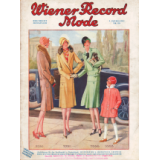
|
Front page, title page or cover of the Austrian illustrated women's and fashion magazine Wiener Record Mode (Eng. title: Viennese Record Fashion) no. 105 for August 1929.
PUBLISHED MONTHLY.
9TH VOLUME, NO. 105.
DESCRIPTION OF THE MODELS ON THE FIRST COVER PAGE:
3750. A chic and practical coat for the transition period. Material: checked English wool fabric. High shawl collar and cuffs in blond fur. Straight cut, at natural waistline, closed with a single button. (Fabric usage: English wool fabric 2.50 m by 140 cm width, pattern size 44).
3751. Jaunty transitional coat made of light fleece fabric in a belted, bloused style, with invisible fastening. Collar made of nutria fur in new lines. (Fabric usage: fleece fabric 2.75 m by 130 cm width. Pattern size 44.)
3752. Coat dress in wool fabric for the transition. This simple, chic style has slightly bloused lines and soft, protruding pleats. The seam division creates a bolero effect. (Fabric usage: wool fabric 2.50 m by 130 cm width. Pattern size 44).
3753. Girls' coat for the transition. Little model made of pastel pink wool fabric in a loose, straight cut. High collar made of white rabbit or coney fur, white mother-of-pearl buttons. (Fabric usage: wool fabric 1.75 m by 130 cm width. Pattern size 8—10 years).
ALL PATTERNS IN STOCK.
Delivery for the book trade in Germany: HOFFMANN & OHNSTEIN, LEIPZIG.
PRICE INCLUDING PATTERN SHEET 75 PFENNIGS, PLUS LOCAL DELIVERY CHARGE.
[Stamp:] Latest seasonal magazines for dresses, coats and costumes already arrived. Fritz Lengenfelder [see first inside cover, note by M. K.], Moden-Buchhandlung und Schnittmuster [Fashion Bookshop and Patterns].
Drawing/illustration: unknown/unsigned.
[Page 1]
|
|
P. 2 |
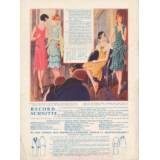
|
3754. Pastel pink crepe georgette makes up the material of this charming evening dress. The skirt section is enlivened with two inserted and pleated sections ending in points. The back is made bloused by a half belt. (Fabric usage: crepe georgette 3.75 m by 100 cm width. Pattern size 42.)
3755. Youthful evening dress made of pastel blue crepe de chine in a simple, regular shape. The scalloped flounces are edged with a darker tone bias tape. (Fabric usage: crepe de chine 3.50 m by 100 cm width. Pattern size 42.)
3756. Youthful evening dress from changeable taffeta. A long, straight and somewhat bloused bodice is attached to the skirt in an arch. Bertha collar made of organdy, finished with a bow made of the same material as the dress. (Fabric usage: taffeta 3 m at 100 cm width, organdy 0.75 m by 100 cm width. Pattern size 42.)
3757. This model made of delicately flowered taffeta is a charming variation of the princess dress. The slanted peplum flounce, which ends with a jaunty bow at the side, gives this evening gown a fancy peculiarity. (Fabric usage: taffeta 4 m by 100 cm width. Pattern size 42.)
RECORD PATTERNS for all styles are available for immediate delivery in the indicated standard sizes with picture and descriptions on the individual pattern pieces at the following prices:
Large patterns GM. 1.— (dress, costume, coat).
Small patterns GM. —.70 (skirt, blouse, children's dress).
Patterns according to personal measurements GM. 4.— (complicated patterns 50% extra charge).
The cheapest way to order in writing is to pay the amount and GM. —.15 for postage to a postal check account, note the order on the section of the same, or advance mailing in stamps, plus GM. —.15 postage. For cash on delivery there is an additional GM. —.30.
Prices of the transfer patterns for our needlework patterns: Size I GM. —.75, size II GM. 1.30, size III GM. 1.80.
Pattern stock in the following cities, available through Record sales offices in:
Brunswick, Bohlweg 49, Heinrich Boennighausen.
Breslau, I. Bluecherplatz 20/I, Heinrich Diegmann, telephone: Ohle 7624.
Dessau, theater building, Joh. Rothe.
Dresden-A., Wallstrasse 12, Alwin Krause.
Elberfeld, Wallstrasse, Ph. Freudenberg.
Frankfurt a. M., Goethestrasse 27/1, J. & M. Martens.
Freiberg, Erbische Str. 2—4, Carl Hubricht.
Halle a. Saale, Gr. Ulrichstrasse 6—8, W. F. Wollmer.
Hamburg, Heuberg 1, B. Meyer.
Hanover, Karmarschstrasse 5, C. Westermann.
Hirschberg, Adolf Staeckel & Co.
Kassel, Oberste Gasse 28, A. Waege.
Kiel, Knooperweg 22, C. Fries.
Cologne a. Rhine, Glockengasse 13, Heinr. Kramer.
Leipzig C 1, Hospitalstrasse 2, Hoffmann & Ohnstein, telephone 10890.
Magdeburg, Schuhbruecke 10, Hans Kaufmann.
Mainz, Mittlere Bleiche 41, F. Schaudt.
Munich, Utzschneiderstrasse 9, H. Staudinger, telephone 20483.
Nuremberg, Adlerstrasse 14, F. [Franz] Lengenfelder.
Where not available: through HOFFMANN & OHNSTEIN, LEIPZIG C 1, HOSPITALSTRASSE 2. Postal check account, Leipzig no. 52.923.
[Page 2]
|
|
P. 3 |
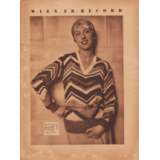
|
Cover of the illustrated Wiener Record Mode no. 105 for August 1929.
[Full-page fashion photograph:] Knitted sports jumper, in a striking combination of navy blue, gray and white. Phot. YVA, Berlin.
Photo: "Yva" (Else Ernestine Neulaender-Simon, 1900-1942).
[Page 3]
|
|
P. 4 |
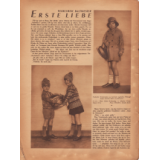
|
Article:
Baltinester, Wilhelmine, First Love (by Wilhelmine Baltinester, 1900-1980).
[Photograph top right:] Practical children's coat made of checked English wool fabric. Model: BETTE, BUD & LACHMANN.
Left: Lively children's knitted suits in vivid colors. Model: COTA. Photos: BECKER & MAASS, Berlin. Photos: Studio Becker & Maass, Berlin.
[Page 4]
|
|
P. 5 |
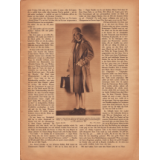
|
Article:
Baltinester, Wilhelmine, First Love (by Wilhelmine Baltinester, 1900-1980).
[Fashion photograph in the center:] Elegant travel suit: black and white checked English tailor-made suit, overcoat of light grey wool fabric with silver-framed mother-of-pearl buttons; hat woven from felt. Model: KLYHS. Photograph: YVA, Berlin. Photo: "Yva" (Else Ernestine Neulaender-Simon, 1900-1942).
[Page 5]
|
|
P. 6 |

|
Article:
Roda Roda, Grandfather's Vade Mecum (by Alexander Friedrich Ladislaus Roda Roda, 1872-1945).
[Roda Roda, Grandfather's Vade Mecum.]
The eight-hour train ride was finally almost over. Jesus, that was torture! The inhuman heat, the dust and smoke. There were three or four ladies in the corridor who kept standing outside to get a bit of air. He couldn't join them, he would have had to button his dress-shirt and put on his tie. In this glowing heat? He preferred to try all six velvet seats one after the other, staying in each for half an hour, smoking — and sighing with boredom, heat and impatience.
Then the strangely shaped mountains that gave the city its name appeared at its feet. They rise up from the plain without any transition, the tent mountains, and in the uncertain light of the evening they really do resemble large camp tents.
Many years ago, as a little boy, he passed by here every year — with his dad and mom when they went on vacation. Back then, his boyish imagination conjured up a huge army in these giant tents. The pounding of the train sounded to him like the noise of battle. Shuddering with horror and pleasure, he had imagined how the tent walls would open in the morning mist: trumpeters in front, and behind them, sparkling in the red early morning light, the armored riders, the glittering giant snake stretching its lambent head from Zeltstadt — swords spraying, a thousand wounds burning, and in the evening the hero who rode first behind the trumpeters into the young morning enters Zeltstadt as the victor.
Georg looked back at the vanished mountains with a smile. The sun was shining brightly today and chased away all fantasies. The battle had never been fought — Zeltstadt lay peacefully as it had twenty years ago, enjoying prosperous progress thanks to the mayor's care.
Finally, finally, the little station, Georg's destination. Greeted reverently by the official, he passed through the platform gate, stepped out onto the street and looked around searchingly.
At the same moment, Mathes, his old coachman, stopped the horses. "Excuse me, Your Grace, the train has arrived on time today…" — Mathes had not expected such coincidences.
"Good day — how are you?" Georg wanted to ask — but swallowed his words. Why provoke complaints that he didn't know the answer to?
He only glanced briefly at Mathes. "It doesn't matter. I've only just got out." — A brief nod. Mathes left his place on the coachman's seat and sat down on the servant's seat. The young gentleman took the reins.
Otherwise, in the old days, Mathes had been allowed to sit next to the young gentleman, who then gave him one of the city cigarettes and let him tell him something. Now he sat at the back — dismissed, condemned to silence. — And Mathes' heart became even sadder.
They drove through the countryside between fields and meadows. The fields had been cleared, dark clumps of sheep were grazing on the poor weeds. One particularly good host had already pulled up his stubble. The land strip of Neuriss ran like a promise through the sadly tired, monotonously yellow, hopeless stubble land. … [continued on page 8].
Advertising:
[Self-promotion of the publisher Société Graphique, Aktiengesellschaft fuer Modeverlag (stock company for fashion publishing), Vienna XVIII.] FOR THE AUTUMN SEASON WE RECOMMEND our seasonal albums listed below, which contain a rich selection of elegant, yet simple Parisian and Viennese models of all women's and children's fashions.
STAR no. 23, the most popular seasonal album; contains around 500 elegant models in a magnificent cover, 52 pages on art paper, 20 of which are printed in artistic color.
Grosse Wiener Modenwelt [Great Viennese Fashion World] no. 30 (SMART). Large seasonal album, indispensable for every fashion atelier. The journal contains 44 pages in a splendid cover, 20 of which are printed in artistic color, approximately 400 models.
Wiener Modenspiegel [Viennese Fashion Review] no. 10 (STELLA). Rich seasonal album with 52 pages, 12 of which are printed in color. 400 simple and easy-to-execute patterns for all women's and children's fashions.
L'Elegance Féminine [Feminine Elegance] no. 18, a new seasonal album with 16 color pages and 16 black pages containing around 300 models in artistic pen and ink drawings. The album is produced entirely on the finest art paper.
[Page 6]
|
|
P. 7 |
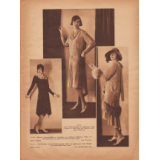
|
[Page with three fashion photographs]
CENTER: Fancy afternoon dress in coffee-brown crepe georgette with delicate bias stitching and a bell skirt extended at the back.
Left: Elegant afternoon dress in princess shape made of black China crepe; collar and cuffs entirely embroidered with white and black pearls. Model: BECKER. Phot. YVA, Berlin.
Right: Three-quarter-length coat to the afternoon dress (center) in coffee-brown crepe georgette trimmed with fox fur of the same color. Model: HAUCK. Phot. FELDSCHAREK, Vienna.
Photos: "Yva" (Else Ernestine Neulaender-Simon, 1900-1942); Josephine (Pepa) Feldscharek (1899-1962).
[Page 7]
|
|
P. 8 |
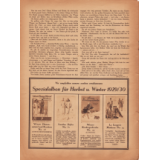
|
Article:
Roda Roda, Grandfather's Vade Mecum (by Alexander Friedrich Ladislaus Roda Roda, 1872-1945).
[Roda Roda, Grandfather's Vade Mecum.]
[Continued from page 6] … Now the first village. Geese, chickens and children, who had been playing together in the dust, fled to the safety of the yard. The dogs jumped yapping at the wheels, accompanied the wagon a little way and then stayed behind, conscious of their duty fulfilled.
The farmers greeted them with their hats tipped low.
They did not greet Georg. They tipped their hats to the yellow wagon, to Mathesen's blue coat — as their fathers had done forty or fifty years ago to another yellow wagon, another blue coat — without waiting for a return greeting or thanks. Baron Neudorf held the reins in his fists then too. Him or another — the peasants are the same, their greeting is for the family.
In the middle of the fourth village, Georg turned sharply to the right, into his park, and stopped at the ramp.
Without looking back at Mathes, he walked up the ten steps into the house.
The coachman's wife — his parents' former cook — came to meet him. He also returned her greeting fleetingly, intimidatingly. — The matter must be dealt with as briefly as possible, as gently as possible.
There's a huge, boring document that two clever lawyers have drawn up, eager to somehow pull a particularly devious trick on each other. Tomorrow he puts his name to it — and that's it…
Everything that was there has then sunk: — parental home — childhood memories — yes, even worries and debts. Sunk as if it had never been. Like the rider in the moor under the tent mountain — the legend once eerily resounded in his childhood room. — The corner room to the right of the hall was his nursery.
Just enough time for a walk through the park. Georg stepped out of the drawing room onto the small terrace facing the garden.
They used to drink coffee here…
From both sides, large spruce trees stretched their branches towards each other like eternally separated lovers. As if they had escaped from the coniferous forest that surrounded the park's large lawn. Arabesques of rose-colored asters flowed down the slope. But in front of the black, austere spruces — far above — stood a maple tree in a coquettish, light-colored silk dress — like a small, anemic, nervous duchess in the circle of her cavaliers.
Georg strode aimlessly around. He had walked through the avenues of chestnut trees and along the rose path, before which the stream of blossoming asters respectfully stopped.
Then a hoarse bell called for dinner.
Mathesen's wife had prepared it. He didn't really like the taste of it. "Last meal," he remembered, and the bite stuck in his throat.
He sat alone — at the head of the table that had so often seen a cheerful round in his childhood years.
Where were they all who had sat here? What would they say to the news that he had sold his parents' house?
His gaze slid over the shelves that ran around the walls of the dining room. The Meissen plates, his grandfather's pride and joy — must they too…?
God, what should he do with them?
The clock? The tired portrait of a woman laughing at him? Who is she? And who was she?
Georg suddenly stopped eating and retreated to the library.
"You must go to bed, Mathes. Tomorrow morning you'll fetch two gentlemen from the train… your new masters."
"Oh, Your Grace — Mr. Georg…"
Georg waved his hand so imperiously that the coachman disappeared without a word.
Then he sat alone in the still, silent night. And sat in the same place where his father, grandfather and great-grandfather had sat before him, worrying and calculating, pondering and deciding. … (end on page 35).
Advertising:
[Self-promotion of the publisher Société Graphique, Aktiengesellschaft fuer Modeverlag (stock company for fashion publishing), Vienna XVIII.] We recommend our just published special albums for fall and winter 1929/30.
Wiener Damenmaentel und Kostueme [Viennese Women's Coats and Suits] no. 25 (CONFECTION MODERNE) is the most sought-after and beautiful issue of its kind and contains about 120 elegant, yet simple and practical coats and costumes on 32 pages.
London Styles no. 31, large luxury album, indispensable for every ladies' tailor; excellent edition for coats and suits in the "tailor-made" style. A large part of the plates consisting of the finest art print cardboard is executed in artistic watercolor.
Wiener Kindergarderobe [Viennese Children's Clothing] no. 24 (L'ENFANT). Large album of children's fashion, about 150 delightful children's, young misses' and boys' models, mostly in artistic color printing. The album contains a large pattern sheet as a free addition.
La Lingerie Moderne [Modern Lingerie] no. 19, an exquisite special edition of all underwear fashions for women, men and children. The very rich, artistically executed album contains a free pattern sheet.
[Page 8]
|
|
P. 9 |
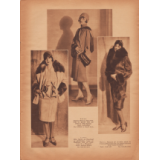
|
[Page with three fashion photographs]
CENTER: Elegant coat made of light wool crepe with a distinctive scarf and fur trim (Hilde Schroeter). Model: GALLEWSKI. Phot. BECKER & MAASS, Berlin.
LEFT: Light-colored suit made of fleece fabric with a jumper of the same color made of China silk crepe; jacket with lynx fur trim (E. v. Winterfeld). Model: FRIEDLAENDER. Phot. BALAZS, Berlin.
Right: Fur coat for cool evenings made of brown, foal-like fur, broadly trimmed with dark fox (Lydia Gundlach). Model: MARYART. Phot. BALAZS, Berlin.
Photos: Studio Becker & Maass, Berlin; Studio Alexander Balázs, Berlin (1890-1932).
[Page 9]
|
|
P. 10 |
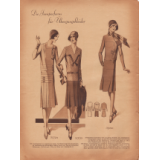
|
The Jumper Shape for Transitional Dresses.
3778. Morning dress made from beige cashmere. The middle section has wide horizontal panels with alternating buttons in the same color. Skirt with right-sided pleats. (Fabric usage: 2.50 m by 130 cm wide.) Pattern size 44.
3779. Simple jumper dress. Skirt made of smooth wool fabric, with groups of pleats. Jumper made of plaid fashion wool fabric. Belt and trims and bows made from the skirt material. (Plain wool fabric 1.30 m by 130 cm wide, plaid wool fabric 1.50 m by 130 cm wide). Pattern size 44.
3780. Chic morning dress made of dull blue wool crepe in a belted jumper shape. The shoulder yoke continues as a panel, which is guided by incisions. A large embroidered monogram and a colorful spotted scarf complete this youthful style. (Fabric usage: 2.50 m by 130 cm wide.) Pattern size 44.
[Page 10]
|













